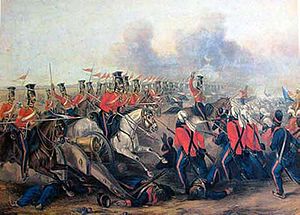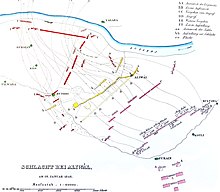Battle of Aliwal
| date | January 28, 1846 |
|---|---|
| place | Aliwal in India |
| output | British victory |
| Parties to the conflict | |
|---|---|
| Commander | |
| Troop strength | |
| 11,000 men | about 12,000 men irregular cavalry 70 cannons |
| losses | |
|
50 cannons |
|
Mudki - Ferozeshah - Aliwal - Sobraon
The Battle of Aliwal was a military conflict on January 28, 1846 between the British East India Company and the Sikh Army of the Punjab in the First Sikh War .
prehistory
On January 17, 1846, the Commander-in-Chief in India, Gough , sent Major General Harry Smith with a brigade of infantry, two Indian cavalry regiments and artillery to provide escort to the supply train to the main army. On the way he captured a small fort at Dharmkot held by Muslim mercenaries . Dharmkot fell without loss and Smith was ordered to relieve Ludhiana, threatened by a Sikh army under Ranjodh Singh . He also received some reinforcements before he met the army of Ranjodh Singh on January 21, 1846 near Baddowal . This comprised 8,000-9,000 men and 40 guns and was thus twice as powerful as Smiths with only 4,000 men and 18 guns. Smith decided to avoid the fight and bypass the enemy south. He managed to do this with only a few losses, including all of his luggage. Ranjodh Singh also received 4,000 reinforcements.
course
On January 28th, Smith decided to seek combat. His troops now numbered 11,000 men, while Singh had 12,000 men and 70 cannons. The combat formation rested on Aliwal on the left flank and Bundri on the right . The Sikhs were surprised by the arrival of British troops, and Smith ordered an infantry attack on the Sikhs 'left flank at Aliwal while simultaneously letting the 16th Lancers, a cavalry regiment, attack the Sikhs' right flank. After a brief struggle, the Sikhs' left flank gave way and fled, General Singh among them. On the right flank, the Sikhs offered strong resistance until they withdrew. An attempt on their part to rally at Bundri was unsuccessful. The British drove the Sikhs back across the Satluj and captured over 50 cannons.
Effects
After the battle, Ghulab Singh first contacted the British to negotiate peace. The British called for the Sikh army to be disbanded. This was not in the power of the Sikh leaders, who had only limited control over their army, and so their destruction on the battlefield became a prerequisite for the fulfillment of the Sikh leaders' plans.
Individual evidence
- ↑ George Bruce Malleson: The Decisive Battles of India . From 1746 to 1849 inclusive. Associated Publishing House, New Delhi 1973, pp. 318f. ISBN 978-0-554-47615-5 (English).
literature
- George Bruce Malleson: The Decisive Battles of India . From 1746 to 1849 inclusive. Associated Publishing House, New Delhi 1973, ISBN 978-0-554-47615-5 (English)


